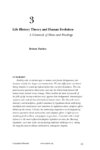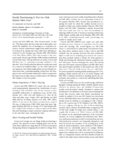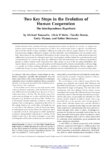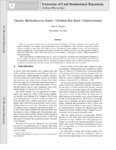|
|
Creator | Title | Description | Subject | Date |
| 76 |
 |
O'Rourke, Dennis H. | Hrdlič̌ka's Aleutian population-replacement hypothesis: a radiometric evaluation | In a 1945 monograph, Hrdlička argued that, at 1,000 BP, Paleo-Aleut people on Umnak Island were replaced by Neo-Aleut groups moving west along the island chain. His argument was based on cranial measurements of skeletal remains from Chaluka Midden and mummified remains from Kagamil and Ship Rock b... | Population replacement; Paleo-Aleuts; Neo-Aleuts | 2006 |
| 77 |
 |
Hawkes, Kristen | Life history theory and human evolution : a chronicle of ideas and findings | Fertility ends at similar ages in women and female chimpanzees, but humans usually live longer and mature later. We also differ from our closest living relatives in weaning infants before they can feed themselves. The comparisons pose questions about when and why the distinctively human life history... | | 2006-01-01 |
| 78 |
 |
Hawkes, Kristen | The derived features of human life history | This chapter compares and contrasts the life histories of extant great apes in order to construct a hypothetical life history of the last common ancestor of all great apes and to identify features of human life history that have been derived during the evolution of our lineage. Data compiled from th... | | 2006-01-01 |
| 79 |
 |
Rogers, Alan R. | How much can fossils tell us about regional continuity? | Presents a study on the genetic contribution of earlier populations to later populations within regions called regional continuity. Testing for regional continuity with multiple characters; Replacement of archaic population by a population of modern humans. | Human genetics; Fossils; Regional continuity | 2006-06-05 |
| 80 |
 |
Cashdan, Elizabeth A. | Ethnocentrism and xenophobia: a cross-cultural study | Analyzes the factors influencing ethnic affiliation and interethnic hostility. Relationship between intraethnic loyalty and risk of famine; Continuity of violence at different levels of groupings; Analysis of local and intercommunity conflict. | Ethnic relations; Ethnology | 2006-06-06 |
| 81 |
 |
McElreath, Richard | New methods in quantitative ethnography: economic experiments and variation in the price of equality | A new method for quantitatively documenting concerns for economic fairness has the potential for identifying variation in prosociality within and across societies. Multiple dictator games conducted in two small-scale societies presented decision makers with a choice between an equitable and an ine... | Inequality; Payoffs; Prosociality | 2007-12 |
| 82 |
 |
Harpending, Henry C.; Jorde, Lynn B. | Culture creates genetic structure in the Caucasus: autosomal, mitochondrial, and Y-chromosomal variation in Daghestan | Near the junction of three major continents, the Caucasus region has been an important thoroughfare for human migration. While the Caucasus Mountains have diverted human traffic to the few lowland regions that provide a gateway from north to south between the Caspian and Black Seas, highland populat... | Caucasus; Haplogroups; Autosomal variation; Mitochondrial variation; Y-chromosomal variation; Endogamy; Avar; Dargin; Kubachi; Culture | 2008 |
| 83 |
 |
Cashdan, Elizabeth A. | Waist-to-hip ratio across cultures: trade-offs between androgen- and estrogen-dependent traits | A gynoid pattern of fat distribution, with small waist and large hips (low waist-to-hip ratio, or WHR) holds significant fitness benefits for women: women with a low WHR of about 0.7 are more fecund, are less prone to chronic disease, and (in most cultures) are considered more attractive. Why, then... | Fat distribution; Gynoid pattern; Body types; Waist-to-hip ratio; WHR | 2008 |
| 84 |
 |
Cashdan, Elizabeth A. | Waist-to hip ratio across cultures: trade-offs between androgen-and estrogen-dependent traits | A gynoid pattern of fat distribution, with small waist and large hips (low waist-to-hip ratio, or WHR) holds significant fitness benefits for women: women with a low WHR of about 0.7 are more fecund, are less prone to chronic disease, and (in most cultures) are considered more attractive. Why, then... | Fertility; Optimum; Fecundity | 2008 |
| 85 |
 |
McElreath, Richard | When natural selection favors imitation of parents | It is commonly assumed that parents are important sources of socially learned behavior and beliefs. However, the empirical evidence that parents are cultural models is ambiguous, and debates continue over their importance. A formal theory that examines the evolution of psychological tendencies to i... | Transmission; Evolution; Culture | 2008 |
| 86 |
 |
Cashdan, Elizabeth A. | Sex differences in aggression: what does evolutionary theory predict? | The target article claims that evolutionary theory predicts the emergence of sex differences in aggression in early childhood, and that there will be no sex difference in anger. It also finds an absence of sex differences in spousal abuse in Western societies. All three are puzzling from an evolutio... | | 2009-08 |
| 87 |
 |
Codding, Brian F. | Explaining prehistoric variation in the abundance of large prey: a zooarchaeological analysis of deer and rabbit hunting along the Pecho Coast of Central California | Three main hypotheses are commonly employed to explain diachronic variation in the relative abun dance of remains of large terrestrial herbivores: (1) large prey populations decline as a function of anthro pogenic overexploitation; (2 ) large prey tends to increase as a result of increasing social p... | Foraging; Resource depression; Prestige hunting; Paleoclimatic variability; Human behavioral ecology; Zooarchaeology; Central California | 2009-11-14 |
| 88 |
 |
O'Rourke, Dennis H. | Unangan past and present: the contrasts between observed and inferred histories | Abstract Academic research focusing on the population and culture history of the Aleut (Unangan) people began in the late 19th century and continues to the present. The papers in this special issue of Human Biology summarize the latest results from archaeological, linguistic, genetic, and morphometr... | | 2010 |
| 89 |
 |
O'Rourke, Dennis H. | South from Alaska: a pilot aDNA study of genetic history on the Alaska Peninsula and the Eastern Aleutians | Abstract The Aleutian Islands were colonized, perhaps several times, from the Alaskan mainland. Earlier work documented transitions in the relative frequencies of mtDNA haplogroups over time, but little is known about potential source populations for prehistoric Aleut migrants. As part of a pilot i... | | 2010 |
| 90 |
 |
O'Rourke, Dennis H. | Introduction: origins and settlement of the indigenous populations of the Aleutian Archipelago | The series of papers in this special issue of Human Biology use an interdisciplinary approach to address regional questions and to integrate disparate Aleutian data into a broad, synthetic effort. The contributors leverage decades of data on Aleut origins, biogeography, and behavior through integrat... | | 2010 |
| 91 |
 |
Harpending, Henry C.; Rogers, Alan R. | Detecting positive selection from genome scans of linkage disequilibrium | Though a variety of linkage disequilibrium tests have recently been introduced to measure the signal of recent positive selection, the statistical properties of the various methods have not been directly compared. While most applications of these tests have suggested that positive selection has pl... | Genome scans; Linkage disequilibrium; Gene trees | 2010 |
| 92 |
 |
Hawkes, Kristen | Family provisioning is not the only reason men hunt | Gurven and Hill (2009) ask, "Why do mean hunt?" As they say, "The observation that mean hunt and women gather supported the simplistic view of marriage as a cooperative enterprise. Greater sophistication suggests that males may often be motivated by mating and status rather than offspring investment... | | 2010-01-01 |
| 93 |
 |
Wiessner, Pauline W. | Wealth transmission and inequality among hunter-gatherers | We report quantitative estimates of intergenerational transmission and population-wide inequality for wealth measures in a set of hunter-gatherer populations. Wealth is defined broadly as factors that contribute to individual or household well-being, ranging from embodied forms, such as weight and h... | | 2010-02 |
| 94 |
 |
Codding, Brian F. | Interpreting abundance indices: some zooarchaeological implications of Martu foraging | Indices of taxonomic abundance are commonly used by zooarchaeologists to examine resource inten sification, overexploitation and gender divisions in foraging labor. The original formulation of abundance indices developed a clear interpretive framework by linking the measure with foraging models from... | Human behavioral ecology; Zooarchaeology; Ethnoarchaeology; Resource intensification; Gender division of labor; Western Australia | 2010-07-20 |
| 95 |
 |
Hawkes, Kristen | Grandmothers and their consequences | Both what we share and don't share with our primate cousins make us human. Easy enough to start a list. At least since Darwin, most would rate moral sentiments as distinctively human. But our modern selves didn't emerge from ancestral apes in one step. When did populations along the way become human... | | 2012-01-01 |
| 96 |
 |
Harpending, Henry C. | J. P. Rushtons theory of ethnic nepotism | Unreciprocated aid among co-ethnics and the emotional intensity of ethnic conflict have long been explanatory challenges to evolutionary science. J. P. Rushton's theory of assortative ethnic affiliation-altruism, mating and friendship directed towards fellow ethnics-derives from his more general the... | | 2012-01-01 |
| 97 |
 |
Hawkes, Kristen | Stag hunts or rearing environments? | Tomasello et al. have made the case that shared intentionality distinguishes humans from our nearest living relatives. What accounts for the difference? The answer they offer is Stag Hunt choices faced by ancestral foragers. Noting problems with that answer, I urge attention to a promising alternati... | | 2012-01-01 |
| 98 |
 |
Codding, Brian F. | A land of work: foraging behavior and ecology | Work is a core theme in many of the major issues and debates in California archaeology. Work is central in understanding why the first Californians entered the region (e.g., Erlandson, this volume): how thousands of years of work following colonization resulted in the overexploitation of particular ... | Human behavioral ecology; Hunter-gatherer; North America: California | 2012-03-15 |
| 99 |
 |
Rogers, Alan R. | Genetic relatedness to sisters children has been underestimated | Males of many species help in the care and provisioning of offspring, and these investments often correlate with genetic relatedness. For example, many human males invest in the children of sisters, and this is especially so where men are less likely to share genes with children of wives. Although t... | | 2013-01-01 |
| 100 |
 |
Harpending, Henry C. | Paternal age and genetic load | The incidence of base substitutions in humans increases with the age of the father, which shows up as an increased incidence of mutational disorders in the children of older fathers. There is a less obvious implication: an extended period of high average paternal age in a population will lead to inc... | | 2013-01-01 |

























